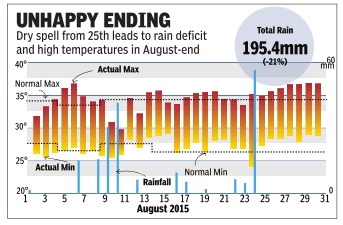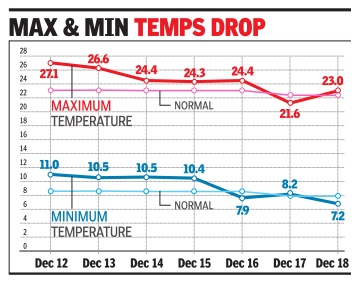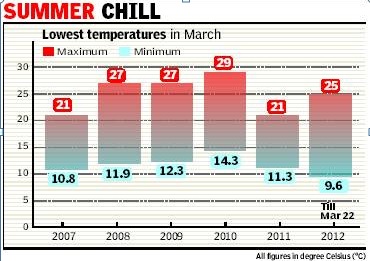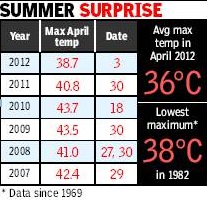Delhi: Climate
(→2015: August rainfall 21% below normal) |
(→December) |
||
| Line 58: | Line 58: | ||
=December= | =December= | ||
| − | Maximum and minimum temperatures in Delhi, 12-18 Dec, 2016 | + | ==Maximum and minimum temperatures in Delhi, 12-18 Dec, 2016== |
[[File: Maximum and minimum temperatures in Delhi, 12-18 Dec, 2016.jpg| Maximum and minimum temperatures in Delhi, 12-18 Dec, 2016 <br/> [http://epaperbeta.timesofindia.com/Gallery.aspx?id=19_12_2016_006_025_011&type=P&artUrl=Delhi-feels-real-chill-as-temp-drops-4C-19122016006025&eid=31808 ''The Times of India'']|frame|500px]] | [[File: Maximum and minimum temperatures in Delhi, 12-18 Dec, 2016.jpg| Maximum and minimum temperatures in Delhi, 12-18 Dec, 2016 <br/> [http://epaperbeta.timesofindia.com/Gallery.aspx?id=19_12_2016_006_025_011&type=P&artUrl=Delhi-feels-real-chill-as-temp-drops-4C-19122016006025&eid=31808 ''The Times of India'']|frame|500px]] | ||
Revision as of 16:40, 10 February 2017
This is a collection of articles archived for the excellence of their content. |
Contents |
March
April
2012
Neha Lalchandani
This was the coolest April in 30 years
The month’s highest temperature in 2012 — 38.7 degrees celsius on April 3 —was the lowest maximum in April since 1982, and the second lowest since 1969. A spate of fast-moving western disturbances were responsible for this freakish cool spell, say weather experts. As a result, there was not a single day when heat wave was declared in any part of northwest India during the month. If all this wasn’t unusual enough, Delhi also witnessed moderate fog on the morning of April 27, a phenomenon that has probably never occurred in the capital city this time of the year. A western disturbance is the name given to cool air currents blowing towards north India from the Mediterranean Sea, particularly in winter when these bring in snow, rain and cold winds. String of wet days kept temp down New Delhi: For the first time in 18 years, the capital witnessed a more-or-less pleasant April, with the temperature never touching 40 degrees Celsius. The average maximum temperature for the month was 35.7 degrees Celsius, against a normal average of 36 degrees. The average minimum was 21.7 degrees while the average day temperature was 28.7 degrees. Since 2007, there have been at least three years that have experienced lower average daily temperatures. These include 2007, 2011 and 2001 in which the average monthly temperature was 26.6 degrees, 28.1 degrees and 28.4 degrees, respectively. B P Yadav, director IMD, said April this year was also characterized by eight days of rain, all occuring in the last 20 days. “The first 10 days were completely dry and characterized by high temperatures. The city recorded 18.3 mm rain against a normal of 11.5 mm. This is quite unusual but in the 125 years of India’s meteorological history, we have had at least 12 such years in which April saw below 40 degrees temperatures and higher than average rainy days,” he said. Senior Met scientists attributed the unusual weather to about six western disturbances that affected northwest India in the second half of the month. “Normally WDs would have moved northwards by now and would not have affected northwest India this actively. However, so far the WDs have continued on their more southerly track and brought rain to the plains. Delhi has witnessed some amount of rain every alternate day since April 10 which has kept temperatures low this season,” said a senior scientist. Dr R K Jenamani, director in-charge IGI Met, added that the WDs also moved much faster this time, assisted as they were by strong westerly winds.
July
2015

The Times of India, Aug 01 2015
July surprise: Rain kept weather mild, air clean
Beating forecasts of a relatively dry and oppressive month, the weather in Ju y came as a pleasant surprise or Delhiites. The city saw as many as 18 rainy days, which kept temperatures in the mild zone for most part of the month. The rainfall also ensured hat air pollution levels in July were among the lowest in recent months, with the PM2.5 evel breaching the safe limit of 60 microgram per cubic metre only on eight days.
The city received total rainfall of 235.4mm during he month, 12% above the normal of 210.6mm. What stood out in the rain pattern was its distribution through the month, with the first shower being recorded on July 6 and he last on the 31st. Only on two days -July 11 (93.8mm) and July 12 (68.6mm) --did the rain turn into a deluge and caused major disruptions in the city's traffic flow.
July usually has the most oppressive weather of the year in Delhi, with high humidity coupled with heat pushing up use of air-conditioners for periods longer than any other time of the year. That's why the city invariably reaches its highest peak electricity load in July , beating the record high of the previous year. But 2015 has been different. This year, the peak load was reached in June and it was less than last year's record. While June saw the maximum temperature in Delhi hitting 45 degree Celsius as a heatwave across India made international news, July did not see the mercury touch 40 degrees on any day .
The maximum temperature during the month was 39.8 degrees C recorded on July 4. In contrast, July last year had six 40 degree-plus days. The unusually mild July weather this year was not without precedent. It closely resembled conditions experienced in 2013, when the highest July rainfall in 10 years was recorded in Delhi. The difference, however, was that a markedly different weather was expected in 2015, because it's an El Nino year.
August
2015: August rainfall 21% below normal
The Times of India, Sep 01 2015

Rains dried up in last week of August, leading to a monsoon deficit of 21% for the month and ushering in days of relatively high heat and humidity . The dry spell, from August 25 onwards, was part of a larger weakness in the monsoon which affected the entire northern plains of the country .
For the capital, however, the absence of rain interrupted what had been till then a pleasant month of August, with frequent rainy days and temperatures firmly in the pleasant zone.
According to readings at the Safdarjung station, the month had 14 rainy days, three more than normal. Despite that, August ended with a high rain deficit mainly because there were hardly any spells of sustained heavy rain. The wettest day of the season (Aug 24) saw 56mm rainfall, hardly much for August. In fact, August has seen wetter days in each of the past 10 years.
December
Maximum and minimum temperatures in Delhi, 12-18 Dec, 2016

The Times of India

